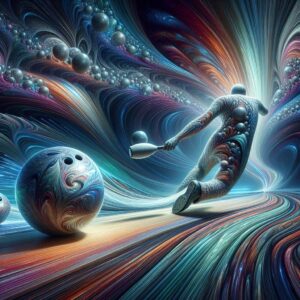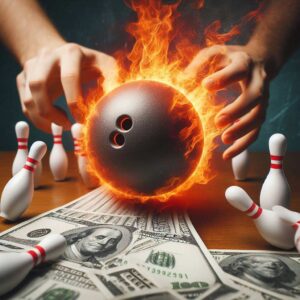Bowling is a beloved pastime across generations. The smooth lanes seem basic on the surface. But have you ever wondered – what exactly are bowling lanes constructed from under the glossy exterior?
As it turns out, quality bowling lanes are precision-engineered from layered materials designed for specific purposes. Custom combinations of wood, synthetics, and conditioning oils work together to provide the ideal ball roll and pin action. Proper construction and maintenance help lanes stand up to years of striking and sparing.
This article will guide you through the layered makeup of regulation bowling lanes. We’ll unwrap the lane components involved in creating just the right ratio of slide and friction. Let’s roll!
The Stable Wooden Base Layer
Beneath the slick surface sliding balls down the alley lies a sturdy wooden base. This provides firmness and flexibility to support bowling activity without cracking or buckling over decades of play.
Hard maple lumber is most often used to construct the lane’s central beam. Its close grain lends to strength and shock absorption. Sometimes lighter pine or softer woods are alternated for flexibility. These wooden bases feature precisely-placed lumber grains running lengthwise down the alley to handle heavy rolling balls.
Why choose wood instead of concrete or other stiff materials? The slight give of maple wood creates more “slide” – allowing balls to glide smoothly without jarring bowlers’ elbows and shoulders over repeat games. Yet its semi-porous nature still enables some grip when an oil conditioning pattern is applied on top.
Synthetic Surface Layers are Key
While wood forms the structural base, bowling lanes require overlaying layers to create a more durable and friction-appropriate surface. Without synthetic coatings, bare wood would show gouges, scratches, and oil watermarks much quicker under the constant action of rolling balls.
Today most centers rely on a specially-formulated synthetic bowling lane finish applied in liquid form then hardened to protect the wood below. Polyurethane compounds like Guard Plus, Vector Plus, Clarion, and Edge are leading options. Multiple coats of Cliffside Galaxy NX Lane Finish offer longevity with reduced abrasion.
Of course, cost and overall lane usage play into the choice of finishes. Additionally, specialized application and curing equipment is needed to properly prepare the underlying wood and correctly apply modern lane coatings. Keeping up with the latest advances allows contemporary bowling alleys to present attractive lanes that also enhance scoring conditions.
Conditioning Oils Change Everything
Merely combining wood bases with a protective surface layer does not guarantee ideal bowling lanes. The biggest advancement improving the bowling experience is the development of conditioning oil patterns. Applying precise oil distributions enables controlled reactions between the ball’s outer surface and lane for reduced or increased friction.
Typical house shots place more oil along the outer boards with less along the main line. This allows rookie bowlers to score well with less risk of gutter balls. Sport shot patterns feature wider head oil encouraging balls to hook earlier with less backend reaction time. Adjusting lane oils creates balance – letting balls accelerate smoothly then grip slightly to curve into the pins at the desired angle.
Remedy FX Lane Conditioner, Kegel Pattern Plus, QubicaAMF Conqueror Oil, and Brunswick Crowne Oil are leading treatments allowing customized slides, hooks, and pin action. Overheads apply a measured amount of oil from side-to-side and from foul line-to-pin deck for the intended effect. Climate-controlled environments keep oil viscosities steady.
Understanding lane oil technology and techniques elevates bowling from simple rolling to strategic sport. Yet it depends upon the right subsurface stability and slide properties aligning with applied oil traction ratios.
Gutter Systems and Pin Decks Too
Beyond the lane materials themselves, components surrounding bowling surfaces also contribute to game functionality. Along each side lie essential ball-collection gutters measuring roughly 10-11 inches across.
Half-circle channels run nearly 60 feet from the foul line to a pit behind the pin deck area. Balls entering the gutter travel along this sloped conduit before dropping into an underground track returning them to bowlers via automated systems.
Gutters traditionally featured a molded hard plastic construction mounted on a rigid metal framework. Yet frequent ball action caused dents and damaged gutters over time.
Now galvanized steel, ABS plastics plus high-impact end caps, and snap-lock connections better withstand wear while also simplifying repairs or renovations. Brunswick Edge-to-Edge Gutters promises enhanced durability and aesthetics.
Nearby pin decks must absorb the continual collisions of speeding balls knocking down pins and then sweeping away fallen soldiers. These recessed areas sit around 12 inches lower than bowling lanes and run nearly 30 feet out from the foul line position.
Sturdy substructures rely on double joist headers, cross-blocking, and sleeper supports to handle forceful impacts. Pin deck surfaces also require protection – often using maple wood or phenolic materials reinforced with resin fillers. These withstand surface scratches while facilitating smooth pin resets.
In Conclusion: The Makeup Behind Quality Lanes
When visualizing bowling alleys, most customers only notice the polished look of a ball gliding effortlessly into waiting pins. Of course, modern synthetic finishes and conditioned oils receive credit for scoring performance. But the critical ingredients hidden underneath the visible bowling lane exterior shouldn’t be overlooked.
The heart of durable lanes depends on high-quality hardwood bases – expertly constructed from oriented wooden boards bonded with stability-boosting grains running head-to-toe.
Then overlaying finish layers of improved polyurethanes or phenolic coatings seal the structural wood to increase lifespan while enabling controlled speed and hooks. Lane conditioning oils tailored in precise patterns customize ball reactions. Surrounding channels, gutters, and pin decks must also endure ongoing athletics.
Maintenance completes the equation. Attentive centers regularly clean then reapply conditioning oils for ideal friction characteristics. Technicians promptly address damaged sections, re-oiling affected areas to match the original slide and hook intent. Keeping up with equipment upgrades enhances both bowling enjoyment and business reliability into the future.
Now you’re an expert on what lies beneath! Bowling lanes seem simple but actually blend scientific balance with sturdy yet flexible materials standing up over decades of strikes, spares, and split conversions. The right assortment of layered components creates the smooth roll yet hooked pin action that makes bowling such an appealing pastime.
The next time you lace up to hit lane seven, appreciate the technological efforts involved in crafting regulation bowling perfection for enjoyment by all ages. Let your ball guide you but don’t forget what’s sliding underneath!
Frequently Asked Questions
What wood is used to make a bowling lane?
Hard rock maple wood is most commonly used to construct the base of bowling lanes beneath the synthetic surface layers. Its dense grain lends strength and flexibility.
What is bowling lane made of?
Quality bowling lanes feature a hardwood base, usually hard rock maple, overlaid by synthetic materials like polyurethane or high-compression melamine. These are topped with conditioning oils for ideal ball control.
How do bowling lanes not get dented?
The layered construction of modern lanes prevents dents and damage. Hardwood cross-grained bases absorb ball impacts while overlaying synthetic materials resist abrasions. Maintenance crews also frequently apply rejuvenating oils and resurface damaged boards.
What is the difference between wood and synthetic bowling lanes?
Wood lanes feature a natural maple or pine base sealed for protection. Synthetic lanes use materials like durable plastic laminates over the wood base. Synthetics provide more consistency while wood needs more protection yet some desire its classic appearance.
How thick is bowling alley wood?
Bowling alley wood bases are around one inch thick, constructed from edge-glued blocks laminated lengthwise down the lane. The thick hardwood absorbs shocks while staying smooth and level.
Can you make bowling alley at home?
For hobbyists with space and DIY skills, a two-lane home bowling alley is possible using the proper wood, synthetic overlays, conditioning oils, lane capping, and pin reset mechanics. However, it requires expertise to create regulation conditions.
How do you refinish a wooden bowling alley?
Refinishing bowling lanes involves intensive sanding to remove worn upper layers, inspection and repairs to the wooden base, applying new conditioning oils, filling cracks, leveling uneven boards, and finishing with polyurethane sealants.
What are 5 strikes in a row called?
In bowling, five consecutive strikes are called a “five-bagger” or “Turkey Plus Two” indicating three strikes plus two more successive strikes. Players may continue this with six (triple-turkey) or more successive strikes.
What is synthetic bowling lanes made of?
Typical synthetic bowling lanes consist of a melamine resin base reinforcement coated with polyurethane finishes. These create a durable, scratch-resistant layer protecting the wood below while providing a controlled-friction surface finish.





